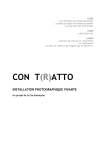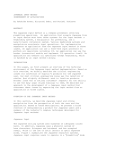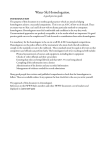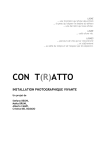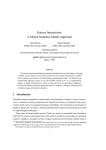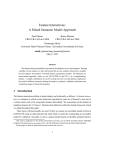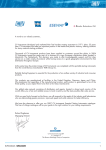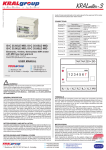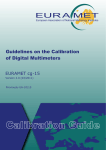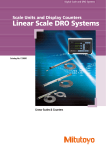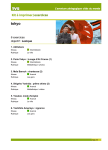Download Recommendations for the proposed CCDM inter - KCDB
Transcript
Fiber optic power responsivity comparison 1 Technical Protocol on comparison of fiber optic power meter responsivity Contents 1. 2. Introduction ............................................................................................... 2 Organization .............................................................................................. 2 3. Description of the standards .................................................................. 5 4. Measurement instructions ...................................................................... 6 2.1. 2.2. 2.3. 2.4. 2.5. 2.6. 3.1. 4.1. 4.2. 4.3. Participants .................................................................................................................................2 Participants’ details ...................................................................................................................3 Form of comparison ..................................................................................................................4 Timetable ....................................................................................................................................4 Handling of artefact ..................................................................................................................4 Transport of artefact..................................................................................................................5 Artefact ........................................................................................................................................5 Traceability .................................................................................................................................6 Measurand ..................................................................................................................................6 Measurement instructions .......................................................................................................7 5. Reporting of results and uncertainties ................................................. 8 Appendix............................................................................................................. 9 Fiber optic power responsivity comparison protocol Fiber optic power responsivity comparison 2 1. Introduction 1.1 The aim of this project is to perform a comparison of fiber optic power responsivity with special interest in linearity. This technical protocol has been prepared by the NMIJ and agreed by all the other participants. 1.2 The procedures outlined in this document cover the technical procedure to be followed during measurement of the transfer standards. 2. Organization 2.1. Participants 2.1.1 The NMIJ is acting as a pilot laboratory in the comparison among the participants. 2.1.2 All the participants must be able to demonstrate traceability to an independent realization of the quantity, or make clear the route of traceability to the quantity via another named laboratory. 2.1.3 By their declared intention to participate in this comparison, the laboratories accept the general instructions and the technical protocols written down in this document and commit themselves to follow the procedures strictly. 2.1.4 Once the protocol has been agreed, no change to the protocol may be made without prior agreement of all the participants. Fiber optic power responsivity comparison protocol Fiber optic power responsivity comparison 2.2. 3 Participants’ details NMI Name (Country) NMIJ (Japan) PTB (Germany) NPL (UK) Personnel Kuniaki Amemiya Stefan Kück Andrew Deadman Fiber optic power responsivity comparison protocol Contact information Laser Standards Section Optical Radiation Metrology Division NMIJ 1-1-1-Central 3 Umezono, Tsukuba, 305-3568, Japan Tel: +81 29 861-4191 Fax: +81 29 861-4259 Email : [email protected] Physikalisch-Technische Bundesanstalt FB 4.5 Optische Technologien AG 4.54 Laserradiometrie Bundesallee 100 38116 Braunschweig Telefon: +49 531 592-4500 Telefax: +49 531 592-694500 E-mail: [email protected] Optical Technologies Group National Physical Laboratory, Teddington, UK, TW11 0LW Tel: +44 20 8943 6077 Fax: +44 20 8943 7176 E-mail: [email protected] Fiber optic power responsivity comparison 2.3. 4 Form of comparison 2.3.1 The comparison will principally be carried out through a fiber optic power meter. 2.3.2 A description of the power meter for use in this comparison is given in section 3 of this protocol. The NMIJ will send a fiber optic power meter. The fiber optic power meter consists of an optical head, which is a photodiode combined to an integrating sphere, a picoammeter as a display unit and an electrical cable connecting them. 2.3.3 The fiber optic power meter is supplied by the NMIJ. 2.3.4 The comparison will take the form of a star type comparison. The NMIJ will calibrate the power meter and then send to one participant. The participant will calibrate and return the package to NMIJ. The NMIJ will recalibrate them to check the drift during the period. The process will be repeated until all the other participants finish the calibration. 2.3.5 Each participant is to send the fiber optic power responsivity and linearity at 1550 nm with the fiber optic power meter to the NMIJ as soon as possible after finishing the calibration. 2.3.6 The timetable given below shows an overview on how the comparison is planned. 2.3.7 Each laboratory has two months for calibration and transportation. With its confirmation to participate, each laboratory has confirmed that it is capable of performing the measurements in the time allocated to it. 2.3.8 If for some reasons, the measurement facility is not ready or customs clearance takes too much time so that it could not meet the timetable, the laboratory must contact the coordinator immediately. 2.4. Timetable (subject to change) Activity Circulation of technical protocol and invitation of participants to members Confirmation of participation by member labs and revision of protocol Submission of technical protocol to TCPR chair for approval Final revision and announcement of kick-off Calibration of NMI 1 (NMIJ, JAPAN) Calibration of NMI 2 (PTB, Germany) Calibration of NMI 3 (NPL, UK) Start Date January 2008 End Date 30 April 2008 30 April 2008 June 2008 Draft A report Draft B report August 2009 April 2010 2.5. July 2008 October 2008 January2009 April 2009 Handling of artefact Fiber optic power responsivity comparison protocol Fiber optic power responsivity comparison 5 2.5.1 The fiber optic power meter should be examined immediately upon receipt. However, care should be taken to ensure that the fiber optic power meter have sufficient time to acclimatise to the rooms environment thus preventing any condensation, etc. The condition of the fiber optic power meter and associated packaging should be noted and communicated to the coordinator. Please use the fax form in the appendix. 2.5.2 The fiber optic power meter should only be handled by the authorized persons and stored in such a way as to prevent damage. 2.5.3 No cleaning of any windows of the fiber optic power meter should be attempted, except using dry air. 2.5.4 During operation of the fiber optic power meter, if there is any unusual occurrence, e.g. change of sensitivity, etc., the coordinator should be notified immediately before proceeding. 2.5.5 Please inform the coordinator via fax or e-mail when the measurements on the fiber optic power meter are completed to arrange a suitable date for dispatch. 2.5.6 After the measurements, the fiber optic power meter should be repackaged in their original transit cases. Ensure that the content of the package is complete before shipment. Always use the original packaging. 2.6. Transport of artefact 2.6.1 It is of utmost importance that the artefact be transported in a manner in which they will not be lost, damaged or handled by un-authorized persons. 2.6.2 Packaging for the artefact has been made which should be suitably robust to protect the artefacts from being deformed or damaged during transit. Care must be taken in order to prevent mould spot growing on the surface of the detector due to changes in temperature and humidity. 2.6.3 The artefact is sufficiently robust to be sent by courier. The packages should be marked as ‘Fragile’. If the possibility arises to hand-carry the packages this should be done. 2.6.4 The artefact will be accompanied by a suitable customs carnet (where appropriate) or documentation identifying the items uniquely. 2.6.5 Transportation is at each participating laboratory’s responsibility and cost. Each participating laboratory covers the cost for its own measurements, transportation and any customs charges as well as for any damages that may have occurred within its country. 3. Description of the standards 3.1. Artefact 3.1.1 The measurement artefact that is the fiber optic power meter will consist of a fiber optic patch cord with FC/APC type connector, an optical head to accept the FC type fiber optic connector end, a display unit, and an electrical cable connecting them. The display unit is provided with an input port to connect the output port of the optical head and an LED display panel indicating the output current of the optical head in electrical current unit. 3.1.2 The fiber optic power meter is sensitive to dust and pollution. When not used they must always be stored with the cover closed. Fiber optic power responsivity comparison protocol Fiber optic power responsivity comparison 6 3.1.3 The fiber optic power meter is shown in Figure 1. The supplying voltage is 100 V. The voltage and the plug may not be compatible with participant laboratories. Appropriate converting adaptor with the ground terminal may easily solve this problem. 3.1.4 A user’s manual of the fiber optic power meter is included so that the participants can refer to it. FC receptacle Optical head Display Unit -----nA Fiber optic patch cord Mains cable Plug Electrical cable Figure 1. Schematic of the fiber optic power meter 4. Measurement instructions 4.1. Traceability 4.1.1 Temperature measurements should be made using the International Temperature Scale of 1990 (ITS-90). 4.1.2 Electrical measurements should be independently traceable to the latest realisation of the Ampere and Volt. 4.2. Measurand 4.2.1 The participants are to measure both responsivity and linearity. The responsivity is defined as the ratio of the reading displayed by the artefact to the optical power determined by the participating laboratory (reading in A per W). The linearity is defined as the ratio of the responsivity at a specific power level to that at a reference level. The measurements should be performed in suitable laboratory accommodation maintained at a temperature as close as possible to 23.0 °C. The exact temperature of the laboratory during the time of the measurements must be reported. 4.2.2 Each independent measurement should consist of the optical head of the fiber optic power meter being reconnected in the measurement facility. It should be noted that each independent measurement may consist of more than one set of measurements, the exact number should be that normally used by the participating laboratory to Fiber optic power responsivity comparison protocol Fiber optic power responsivity comparison 7 obtain the appropriate accuracy as limited by the noise characteristics of their specific measurement facility. The exact number of measurements used should be stated in the measurement report but only the mean or final declared value of the set is required to be included. 4.3. Measurement instructions 4.3.1 The particular combination of the provided optical head and the provided display unit should be used for measurement rather than a combination of the head with another current meter. 4.3.2 Before connecting the fiber optic patch cord with the optical head, it should be inspected for damage or contamination. Some contamination can be easily removed by an air blower or a fiber optic connector cleaner. Any damage or contamination should be documented and communicated to the pilot laboratory using the form given in Appendix. 4.3.3 The participants are to measure the responsivity and linearity of the fiber optic power meter at 1550 nm (standard air wavelength). The types of the sources and their central wavelength with uncertainty should be specified. 4.3.4 If the source wavelengths are detuned from the recommended values, it is the participants’ responsibility to report the actual wavelengths used, corrections to be added to the measurement results for the central wavelength offsets and uncertainties associated with such corrections. The participants should make corrections based on the spectral responsivity data of the transfer power meter determined by its own means. 4.3.5 The participants are recommended to measure the responsivity at five different optical power levels which are 1 mW, 10 mW, 100 mW, 125 mW, and 250 mW, as well as linearity with a reference power of 1 mW at four optical power levels which are10 mW, 100 mW, 125 mW, and 250 mW. The current range of the display unit should be set at 200 nA, 2 μA, 20 μA, and 200 μA for optical powers 1 mW, 10 mW, 100 mW and 125 mW, and 250 mW, respectively. Fiber optic power responsivity comparison protocol Fiber optic power responsivity comparison 8 5. Reporting of results and uncertainties 5.1 The report on the calibrations must contain a comprehensive uncertainty budget, comprising all the contributions to the total uncertainty. The uncertainty of measurements shall be estimated according to the ISO Guide to the Expression of Uncertainty in Measurements. 5.2 The report on the calibrations must include a description of the participants’ measurement facility or a reference to a published work of the facility. It would be useful for a schematic diagram of the facility to be included. 5.3 It is recommendable that the report could be completed by computer and sent back electronically to the coordinator. In any case, the signed report must also be sent in paper form by mail. In case of any differences, the paper forms are considered to be the definitive version. 5.4 Following receipt of all measurement reports from the participants, the pilot laboratory will analyze the results and prepare the first draft report on the comparison. This will be sent to the participants for comments, additions and corrections. Subsequently, the procedure outlined in the BIPM Guidelines will be followed. 5.5 Reporting the results, the following uncertainty contributions should be considered: • • • • • • Uncertainty associated with the reference standard used Uncertainty associated with correction made for the source central wavelength offset or uncertainty associated with the source central wavelength offset (if no correction is made) Uncertainty associated with the correction to the reference condition: - Ambient temperature and humidity Uncertainty associated with the drift during the measurement Current measurement Other additional parameters may be felt appropriate to include dependent on specific measurement facilities and these should be added with an appropriate explanation and/or reference. As well as the value associated with the uncertainty, participants should give an indication as to the basis of their estimate. All values should be given as standard uncertainties. Fiber optic power responsivity comparison protocol Fiber optic power responsivity comparison 9 Appendix Inspection questionnaire of the transfer standards Has the fiber optic power meter transportation package been opened during transit? e.g.Customs …… Y / N If Yes please give details. Is there any damage to the transportation package? …… Y / N If Yes please give details. Are there any visible signs of damage to the detector or housing? …… Y / N If Yes please give details (e.g. scratches, dust, etc). Do you believe the transfer standard is functioning correctly? …… Y / N If not please indicate your concerns. Laboratory: ……………………………………………………………………………………………………… Date: …………………………………………… Fiber optic power responsivity comparison protocol Signature: ………………………………..









